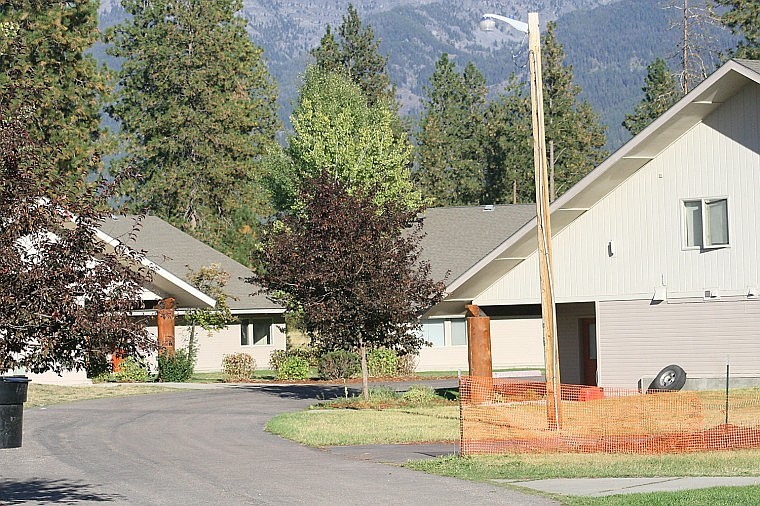SKC battles mold in family housing
Dylan Kitzan | Hagadone News Network | UPDATED 14 years, 2 months AGO
PABLO — Due to record groundwater this season in Lake County, Salish Kootenai College is currently battling a mold issue in their family housing facilities.
“It’s very important for us to provide a safe and healthy environment for everyone at the college,” Dr. Luana Ross, SKC president, said at a press conference on Thursday, Sept. 29.
Three days prior to the conference, on the first day of the 2011-12 school year, SKC was informed by D. Quinn Construction of Kalispell, that three units of family housing had bad mold, forcing one student to be relocated to an additional housing unit on campus. With 55 units in 22 buildings consisting of triplexes and duplexes undergoing inspection, the possibility remains for five to 10 more students to be relocated to hotels for a brief period of time.
“As we review the test results, there may be other units involved,” Walter Fouty, Auxiliary Services Director at SKC, said.
The college has taken quick action, however, hiring Complete Restoration from Kalispell to address the mold issue. Complete Restoration employs a highly-trained and certified staff with 30 years cumulative experience, dealing primarily with mold.
“It’s very fixable,” said Richard Newbury, co-owner and founder of Complete Restoration. “Frankly, we haven’t had a project we cannot fix.”
Complete Restoration uses T2 Mold and Mildew Stain Removal, a patented mold-removal product, which has proven to be 100 percent effective since it was developed eight years ago, on every strain of mold they’ve seen.
Last spring, SKC tested the campus for mold before testing student housing in August. While the dorms and most living quarters checked out, Complete Restoration is still inspecting crawlspaces, which might leave residents out of their living quarters for anywhere from two hours to a day or two, depending on the problem’s severity.
Complete Restoration estimates the process of removing the mold will take several weeks, but as they continue to work their way through the affected areas, they will gain a better understanding of exactly how much time it will take.
“The most important thing to note about that is we will prioritize the most needed areas first,” Newbury said. “In other words, we’re not just going to go down the row. We’re actually going to cherry pick the most pertinent areas and take care of them immediately. We’re going to work down from there.”
In addition to addressing the mold problem, SKC will conduct a post-test after Complete Restoration removes the mold, to ensure that the problem has been taken care of adequately.
“What this administration is doing is complimentary because they’re following a brilliant protocol,” Newbury said. “They’re doing the pretest ahead of time to create a baseline. You do the treatment and the due diligence and you come back in the post-testing and that is exactly the proper protocol. We have the test before and the test after. We know exactly where we’re at.”
SKC is planning on taking actions to prevent the same problems from reoccurring, such as establishing vapor barriers and improving ventilation. Because of the amount of groundwater, which hit hard in late July and should be around until February, the current ventilation system isn’t adequate, according to H.E. “Butch” Burland, SKC Construction Manager.
“Ventilation, moisture and humidity are the factors we have to defeat and those are the things we’ll address,” Burland said.
The process of removing the mold and doing the tests is estimated to cost roughly $200,000, according to SKC Chief Financial Officer Audrey Plouffe. SKC is looking into disaster relief funding from the state to assist in the mold removal.
“We’re guessing the costs are going to be pretty high, but I think the safety of our students and staff is very important and we take it seriously, so we’re going to do what we have to do,” Plouffe said.
The process will be continuous for SKC as they discover who needs to be moved and when, but because they’ve been able to take the proper steps, should have the problem under control.
“It’s necessary,” Newbury said of the mold dilemma, “but it’s fixable.”
ARTICLES BY DYLAN KITZAN

Scarlet Thriller
Arlee outlasts Ronan in an exciting five-game set
MISSION GB RECAP: Tough as nails
BIGFORK - The Mission Lady Bulldogs put forth an inspired effort

Stating their case
POLSON — On Saturday, Jan. 28, hundreds of high school debaters, speakers and performers will converge on Polson for the Montana Class A Speech, Debate and Drama Meet.

